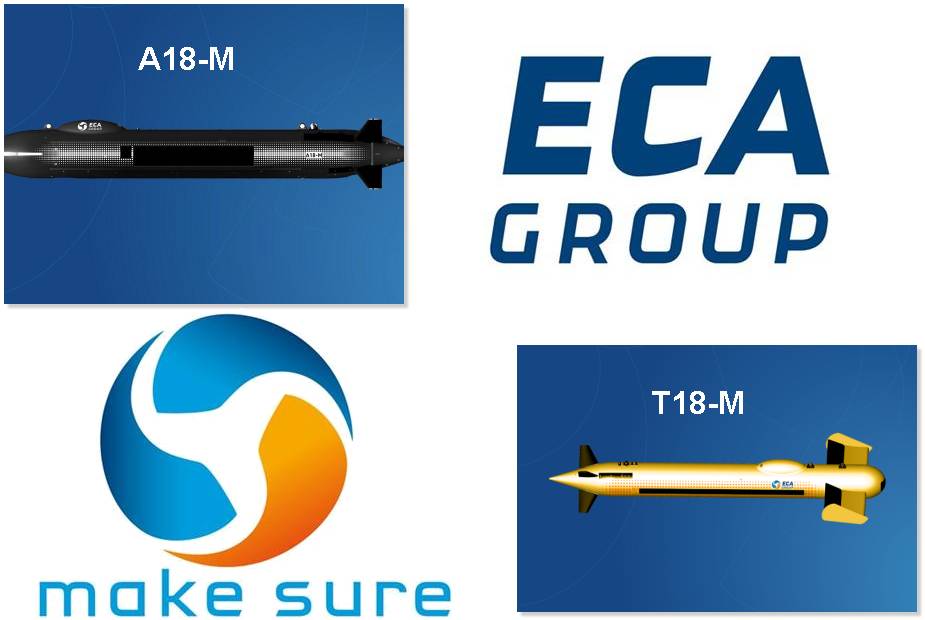According to a press release published on February 16, 2021, ECA GROUP’s UMISAS sonar completed a series of sea trials in the 2nd half of 2020 in preparation of their integration in AUVs and Towed Sonars for the Mine Countermeasures replacement program for the Belgian and Royal Netherlands navies.
Follow Navy Recognition on Google News at this link
 The A18-M AUV (Autonomous Underwater Vehicle) and T18-M Towed Sonar have the best performance when fitted with UMISAS sonars. (Picture source ECA Group)
The A18-M AUV (Autonomous Underwater Vehicle) and T18-M Towed Sonar have the best performance when fitted with UMISAS sonars. (Picture source ECA Group)
As part of the program to replace the naval Mine Countermeasures capability of the Belgian and Royal Netherlands navies, which includes the supply of twelve minehunters equipped with unmanned systems (Toolbox), ECA GROUP announces the completion of sea trials of its UMISAS sonar for both the AUVs and Towed Sonars of the rMCM program. The next step is the on-going production of the UMISAS sonars for their integration in the A18-M and T18-M adapted to the rMCM program. This integration will take place between October 2021 and March 2022.
The A18-M AUV (Autonomous Underwater Vehicle) and T18-M Towed Sonar have the best performance when fitted with UMISAS sonars. Thus, these drones are exclusively commercialized with UMISAS sonars. The A18-M is an underwater drone capable to carry out missions requiring long operating endurance (up to 24 hours), up to 300 meters underwater depth. It is able to host high-performance sonar payloads, such as synthetic aperture sonar (SAS), which provides unprecedented performance.
T18-M is a self-powered towed interferometric synthetic aperture sonar (SAS) for Real Time Detection, Classification and Mapping (SCM) of seabed and moored mines. It is equipped with a thinner umbilical cable and lighter equipment for easier deployment from a USV or another platform. It is a towed vehicle derived from the A18-M. It is specifically designed to meet all recommendations related to mine warfare operations (particularly the detection or classification phases).
ECA GROUP’s research and development in the field of sonars started back in 2014 together with its development of new generation Autonomous Underwater Vehicles in the A18 range. Driven by operational needs of Navies requesting high performance and more compact unmanned solutions for mine detection missions, ECA GROUP brings on the market their own sonar technology to be fitted on its naval drones and fully integrated into its unmanned systems.
The UMISAS sonars are interferometric synthetic aperture sonars (InSAS) used for mine detection missions as part of Mine Countermeasures operations at sea. The UMISAS sonars aim to obtain a spatial resolution of about 3 cm x 3 cm to optimally classify small and irregularly shaped objects on the seabed.
The positioning of the platform required to form the synthetic antennas is an integral part of the UMISAS processing chain. UMISAS directly uses the data from the A18-M or T18-M navigation grade inertial unit to perform SAS processing, thus eliminating the use of low-cost navigation sensors used by some commercial SAS systems on the market which perform only the short term navigation required to produce focused SAS imagery, but do not allow for geo-referencing of the SAS images or improved positioning of the AUV by exploiting the SAS and, above all, are much less reliable.
UMISAS, an Interferometric Synthetic Aperture Sonar (InSAS), is an innovative underwater imaging technology that considerably improves seabed surveys by providing ultra-high resolution imagery at superior coverage rates, i.e. 4 times greater in terms of coverage and between 5 and 10 times greater in terms of resolution compared to conventional side scan sonars. Combining several dozens of acoustic pings to form an image with a much higher resolution, UMISAS processes raw data into 3 cm X 3 cm resolution images, constant with range, together with high area coverage rates (i.e. 1 square nm per hour for the UMISAS 240 fitted on the T18-M).



